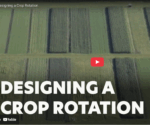The educational materials listed on this page are about Crop Rotation.
Crop rotation is an important part of any sustainable cropping system. As you develop a crop rotation plan, seek out crop rotation guides and examples, which will help you maximize the benefits of crop rotation. For example, see SARE’s Crop Rotation on Organic Farms: A Planning Manual, which includes in-depth information about the advantages of crop rotation and real-world examples of vegetable crop rotation plans and crop rotation charts. Another useful resource is the SARE topic brief Cover Crops for Sustainable Crop Rotations, which summarizes the usefulness of rotating cover crops in any cropping system.
Crop rotation can be employed in many types of cropping systems, including vegetables, agronomic crops, livestock and organic. There are many benefits and advantages of crop rotation: a careful crop rotation plan supports ecological pest management, improves soil health, and helps with nutrient management and soil fertility management, among other benefits. Carefully planned rotations including forage crops and cover crops can improve the sustainability of dairy farming systems. Learn more from the SARE fact sheet Alternative Continuous-Cover Dairy Forage System for Profitability, Flexibility and Soil Health.
Showing 1-2 of 2 results

Organic Field Crop Production Videos
The following videos walk farmers through sustainable concepts and practices for organic weed control, including crop rotations and cultivation techniques. The videos highlight farmer perspectives on these topics and are part of a larger organic field crops course, available at https://courses.organicagronomy.org. Designing a Crop Rotation The concept of crop rotation is not new to organic […]
Integrated Weed Management - One Year's Seeding
Weed biology and ecology can help every farmer become a better weed manager. This guide is the result of a series of winter meetings attended by Michigan farmers, MSU Extension agents and research scientists. It brings together field-tested experience from successful growers and Extension agents and insights distilled from more than 50 years of weed science research.